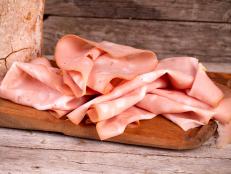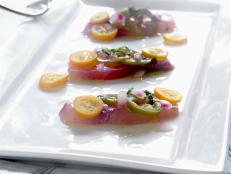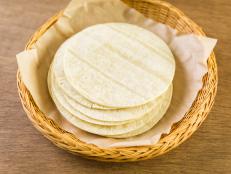What Is Chorizo?
This boldly-flavored sausage is found well beyond Mexico and features in all sorts of delicious recipes from sandwiches and tapas to soups and even burgers.
By Carlos Olaechea for Food Network Kitchen
Carlos is a contributing writer at Food Network.
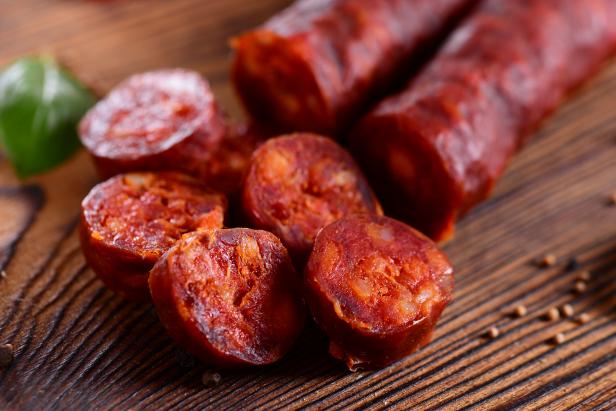
Piotr Krzeslak / Getty Images
Chorizo is a popular ingredient in many Hispanic cuisines, as well as those influenced by Spain, such as the Philippines. Many people in the United States are familiar with chorizo in Mexican cuisine, where it is a very popular taco filling. However, that is just one type of chorizo and only the tip of the iceberg when it comes to this category of sausages. From smokey cured Spanish chorizo to the crumbly Mexican varieties and herbaceous grilled chorizos of South America, there is much to explore within the world of chorizos. Here we explain what chorizo is and break down the differences between each type, including how to cook and enjoy them. By the time you finish reading this, you will become a veritable expert on these types of sausages!
What Is Chorizo?
Chorizo is a type of sausage that originated in Spain and is one of many different types of Spanish sausages. Linguists believe that the word chorizo comes from the late Latin word for salted via the Portuguese word sourico. However, another word for sausage - salchicha - was also incorporated into the Castilian language (what is often referred to as the Spanish language) via Italy. In effect, there are two words - chorizo and salchicha - that both refer to sausages.
In Spain, chorizo often refers to a specific type of pork sausage with many regional variations. This sausage is fermented and cured, resulting in a dry sausage that can often be eaten without cooking, almost like salami or pepperoni. Chorizo often features on charcuterie boards and is a popular tapas dish enjoyed with other small plates and wine.
Chorizo became part of local cuisines wherever the Spanish had colonies. As such, chorizos are widely enjoyed throughout Latin America and the Philippines. Certain countries, like Cuba, have continued using Spanish-style chorizos or have recreated the original recipes, while other countries have completely transformed the original chorizos into unique local styles of sausages. This means that there are dozens of different types of chorizo sausages throughout the world.
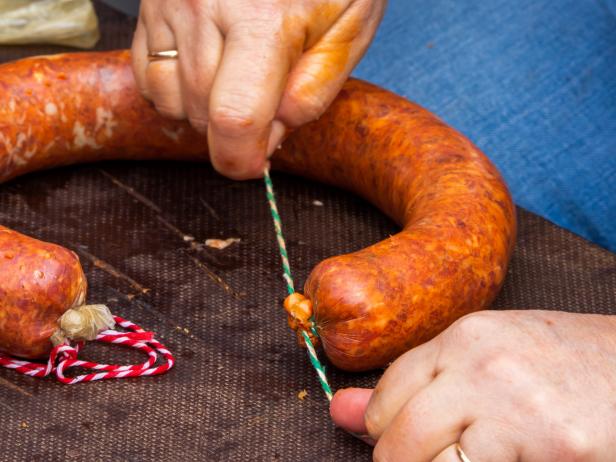
Ana Maria Serrano / Getty Images
What Is Chorizo Made Out Of?
Chorizo can be made from a variety of different ingredients depending on the variety of chorizo and where it is made.
Most Spanish chorizos feature three common ingredients: pork, smoked paprika and garlic. The pork is coarsely chopped and mixed with bits of pork fat and seasonings, which vary based on the region. The mixture is then stuffed into natural casings, and the chorizos are left to cure and dry. One of the main distinctions between different types of Spanish chorizos is their spiciness. Longer, thinner chorizos tend to be spicier while short, fat chorizos are traditionally spicy.
Many types of chorizo outside of Spain also incorporate paprika, but it may not necessarily be Spanish smoked paprika, which would be expensive to import. In some countries, annatto seed is used to give the sausages a reddish color similar to the original Spanish variety. Some Latin American cuisines, especially Mexican, use local chiles for color and flavor, making for spicier chorizo. Mexican chorizos also feature vinegar in the meat mixture to give them a bright, tangy flavor. This was done to mimic the white wine used in some versions of Spanish chorizo.
In the US, Mexican chorizo is typically the most widely available. Less expensive brands of Mexican chorizo are often made from finely ground and seasoned organ meat (spleen is a popular choice) and put into plastic casings from which you squeeze out the filling before cooking.
Latin American chorizos are traditionally made with pork, but an ever-increasing variety of meats and even plant-based options are now popular. In much of South America, chorizo has become a catch-all term for any coarse sausage. These largely vary in size, shape, coarseness and the proportions of the ingredients, but many feature pork, garlic and paprika. Some may feature some additional ingredients, like herbs or local spices. Some South American chorizos stray quite a bit from the original Spanish recipe. In Argentina, for instance, many chorizos are pale in color and feature no paprika, more closely resembling Italian fresh sausages than Spanish chorizo.

Frank Schiefelbein / EyeEm / Getty Images
Different Types of Chorizo
There are too many different types of chorizo to cover all of them here, and brands and chefs are constantly putting out new varieties of chorizo. However, here are few varieties you may come across at grocery stores in the US:
Chorizo Cantimpalo
This is a Spanish type of fully cured and dried chorizo that originated in Salamanca and Cantimpalo regions of Spain. This is the type of chorizo you can slice and serve with bread and Manchego cheese, and it often features on tapas menus. It is also the type of chorizo that is most often used in many Hispanic Caribbean recipes that call for chorizo, including many Cuban dishes. It has a smoky, intensely garlicky flavor and deep red color.
Mexican Chorizo
This is a fresh type of chorizo that needs to be cooked. It’s traditionally made with finely ground pork, although many other types of meats, like offal and plant-based alternatives, are also used these days. Mexican chorizo features a bit of paprika, but most of the color and flavor come from local chiles, like pasilla. Mexican chorizo also features oregano, vinegar and other spices. Unlike other types of chorizo, Mexican chorizo is often cooked without the casing and finely crumbled.
Mexican Green Chorizo
This is another fresh type of chorizo made with finely ground pork or beef mixed with green chiles, tomatillos and fresh herbs that often include cilantro and/or sawtooth coriander. It has a vibrant emerald green color when raw that subsides once cooked. These are harder to come by outside of Mexico or in areas with large Mexican enclaves. Always check the ingredients as some more unscrupulous vendors will add a shocking amount of green food coloring to their green chorizos.
Colombian Chorizo
This is another type of fresh chorizo, which is the norm throughout South America. In Colombia, chorizos are usually grilled or fried whole and eaten with a knife and fork or sliced. They are often eaten with griddled or fried corn cakes called arepas. Colombian chorizo is not as spicy as Mexican chorizo and doesn’t include as much paprika as the Spanish variety. Colombian chorizos can vary from region to region, but many varieties will include finely chopped green onions and fresh cilantro along with garlic and a touch of vinegar.
Argentine Chorizo
Argentina has a dizzying array of chorizos, and many households make their own and have their own unique recipes. Argentina has a very large Italian-descendant population, so much of its cuisine is influenced by Italian flavors and techniques. As such, chorizos in Argentina may feature a variety of herbs like oregano and thyme, nutmeg, garlic and wine. Argentine chorizos are most typically grilled and feature as part of a larger spread of grilled meats. As well, they form part of a popular sandwich called a choripan.

Cavan Images / Getty Images
Mexican Chorizo vs. Spanish Chorizo
Mexican chorizo and Spanish chorizo are the two types you’ll most commonly find in the United States, and these two types of chorizo are very, very different from one another.
The main thing to keep in mind is that Spanish chorizos are often made with coarsley chopped pork that's dried and cured until firm. Therefore, spanish chorizo can be sliced and eaten without cooking, just as you would salami or pepperoni. Mexican chorizos are fresh - made with finely ground, crumbly meat - and need to be cooked before consuming. Mexican chorizo also tends to be spicier than any type of Spanish chorizo.
Mexican and Spanish chorizo are not interchangeable in recipes. If you are making a Mexican dish, make sure to use Mexican chorizo. Spanish chorizo is a must in Spanish dishes, of course, but also shows up quite often in many Cuban dishes. Also keep in mind that neither Mexican nor Spanish chorizos are substitutes for South American or other styles of chorizo.
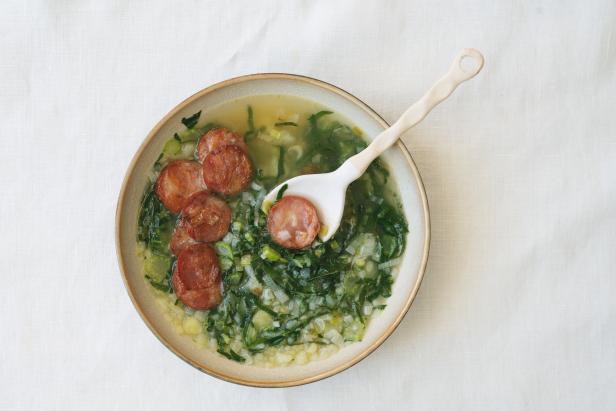
teelesswonder / Getty Images
Is Chorizo the Same As Chourico?
In Portugal, there is a type of sausage called chourico that shares a similar pronunciation with its Spanish equivalent. This type of sausage can look similar to chorizo and is even made with some of the same ingredients: pork, paprika and garlic. However, there are some differences in how chourico is prepared. As well, chourico typically has more seasonings than Spanish chorizo and includes spices that aren’t widely used in Spanish cuisine, like cinnamon. Portuguese chourico is also spicier than Spanish chorizo, and you typically cannot substitute one for the other.
Because the Portuguese, like the Spanish, had colonies throughout the world, Portuguese-style chourico spread across the globe from Brazil to India. Chourico is also popular in New England where many Portuguese immigrants settled, and is an important part of local cuisines in Rhode Island and Southern Massachusetts.
.jpg.rend.hgtvcom.616.411.suffix/1629239756989.jpeg)
©fitopardo / Getty Images
How to Cook Chorizo
Chorizo is quite simple to prepare, especially if you are used to cooking and serving other types of sausage.
How to Cook Spanish Chorizo
Spanish chorizo can usually be sliced and served at room temperature or cold. Some fresh styles of Spanish chorizo do need to be cooked before consuming, and these are usually pan fried, grilled, baked or braised. If using Spanish chorizo in a soup or stew, simply cut a slit down the length of the chorizo and peel off the casing. You can then slice the chorizo into coins of whatever thickness you want and add directly to the pot. You can also bake or fry thin slices of Spanish dried chorizo to make chorizo chips. For other recipes, like Cuban hamburgers called fritas, you will need to process the uncased chorizos in a food processor to make crumbles.
How to Cook Mexican Chorizo
Mexican chorizos are usually cooked without their casings, much like ground beef (called picadillo in Spanish). For this reason, some brands of Mexican chorizo are made with inedible plastic casings that you discard. To cook Mexican chorizo, cut off the ends of the links and squeeze the filling into a hot pan. You don’t need to add oil, since the fat from the chorizo will render and help fry the meat. Thoroughly break apart the meat with a spatula as if you’re making beef taco filling or pasta sauce. Fry the chorizo filling, stirring occasionally, until the fat all renders out and the meat is crumbly.
How to Cook South American Chorizo
The most popular way to cook South American chorizo is to grill it. Poke some holes around each link of chorizo you want to cook with the tines of a fork. This will help some of the juices escape and prevent the chorizos from ballooning and bursting. Always start with a hot grill. Natural charcoal or firewood (what is referred to as lema in Spanish) is most traditional and gives the most flavor. However, gas grills or even grill pans work well. Cook them as you would other types of sausages like bratwurst, kielbasa or Italian sausages. You can also shallow fry South American chorizos, which gives them a crispy, gold-brown crust.
Chorizo Recipes
Cuban Fritas with Matchstick Potatoes
This recipe is for Cuban-style burgers called fritas, which are also hugely popular in Miami where there is a yearly frita competition. The secret to these burgers' bold flavor is ground Spanish chorizo mixed in with the beef.
Chicken-Chorizo Paella
Not all paellas feature seafood, and if a plate full of critters from the deep prevented you from trying this famous Spanish rice dish in the past, this is the recipe for you. The dried Spanish chorizo in this recipe gives a deep, smokey flavor to this dish.
Caldo Gallego
Caldo Gallego is a hearty bean soup from Galicia, a region in Northwestern Spain. Many Galician Spaniards immigrated to Cuba, and this soup is a popular item in many Cuban homes, too. The Spanish chorizo in this recipe adds richness and a bold savoriness to the soup.
Chorizo Refried Beans
Mexican chorizo and refried beans make for a classic combination that is popular in Mexican homes. Here Marcela Valladolid gives us a quick and simple recipe using canned refried beans.
Huevos con Chorizo
Chorizo is a popular ingredient in many Mexican breakfast dishes, including scrambled eggs. Make sure to use Mexican chorizo, whose flavorful rendered fat infuses into the eggs making one of the most flavorsome scrambles you will ever eat.
Queso Fundido con Chorizo
Mexican chorizo is also a common (and delicious) addition to warm cheese dip, which is called queso fundido in Mexico. The smokiness and heat from the chiles add another dimension to this appetizer.
Related Links:























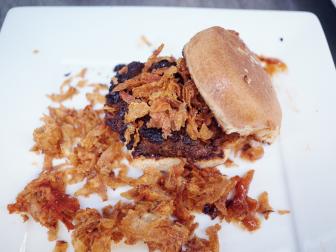


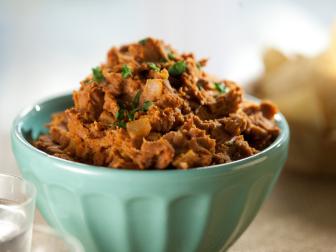
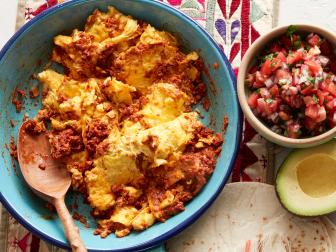
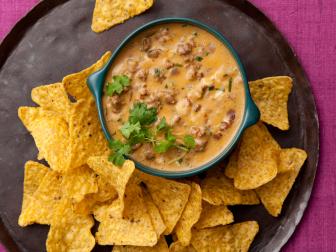


.jpg.rend.hgtvcom.231.174.suffix/1629927600593.jpeg)
